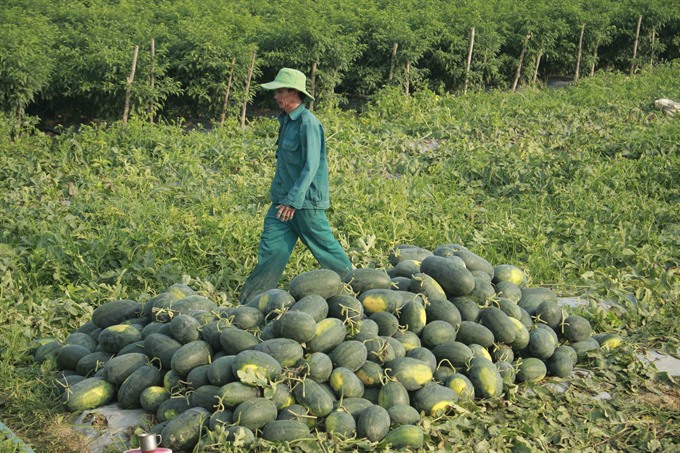 Society
Society

Farmers in the central provinces of Quảng Nam and Quảng Ngãi have been struggling to sell enough watermelons to turn a profit, as the price of the farm produce sharply dropped from VNĐ7,000 ($0.3) per kilo last month to VNĐ1,000 ($0.04) or VNĐ1,200 ($0.05) per kilo in recent days.
 |
| A farmer walks through a pile of harvested watermelon on a farm in Bình Sơn District of Quảng Ngãi Province. Nearly 5,000 tonnes of watermelon remains in stock in Quảng Ngãi and Quảng Nam province. — VNS Photo Huyền Trang |
QUẢNG NAM — Farmers in the central provinces of Quảng Nam and Quảng Ngãi have been struggling to sell enough watermelons to turn a profit, as the price of the farm produce sharply dropped from VNĐ7,000 (US$0.3) per kilo last month to VNĐ1,000 ($0.04) or VNĐ1,200 ($0.05) per kilo in recent days.
The decreased price has left nearly 5,000 tonnes of watermelon on farms in Phú Ninh District of Quảng
Some farmers in Quảng
Dương Văn Hòa, a farmer in Tam Phước Commune of
“This year’s crop was a bumper harvest of watermelon. We expected a good income for the crop, but it’s really a heavy loss for me,” Hòa said.
“Our nine tonnes of watermelon would earn VNĐ50 million, but we could only hope for around VNĐ10 million,” he said.
He said his family had to offer VNĐ500 per kilo at wholesale markets.
Nguyễn Ngọc Anh, in Phú Ninh District, said he spent VNĐ12 million ($530) on labour costs and fertiliser for his own 3,000sq.m farm, but he could face a heavy loss at too-cheap prices.
The Ministry of Industry and Trade warned about lower prices last month, when the watermelon crop in the central region was ready at the same time as the watermelon harvest in
Võ Thanh Anh, from Phú Ninh District’s agriculture office, said the district has a total of 490ha water melon with productivity of 12,700 tonnes.
Anh said two thirds of water melon on farms had been harvested and sold at VNĐ6,000 (0.26 cent) per kilo, but 3,000 tonnes have yet to be sold due to decreased price in recent weeks.
He said the district had planned 400ha for watermelon, but farmers had planed much more, expecting the higher output would correlate with higher profits.
“They (farmers) thought they would earn the best price as last year’s crop, and that’s the reason they expanded the crop area,” Anh explained.
In Bình Sơn District of Quảng Ngãi Province, with an area of 730ha, there remained 1,200 tonnes of watermelon unsold on farm, as the price went down to merely VNĐ1,100 per kilo.
Nguyễn Thị Phương in Bình Chương Commune of Bình Sơn District said she invested VNĐ15 million for her 2,500sq.m melon crop farm, but she would earn only VNĐ8 million – nearly 50 per cent of the crop input investment – at the current low price of VNĐ1,100 per kilo.
She said she would recoup her investment if she could sell watermelon at VNĐ3,000 ($0.13) per kilo.
Almost farmers in four major communes – Bình Thanh Tây, Bình Chương, Bình Hòa and Bình Trị – of Bình Sơn District in the province have suffered heavy losses because of the bumper crop this year.
Vice chairman of Bình Sơn District’s People’s Committee Nguyễn Quang Trung said poor marketing and post-harvest technology as well as inadequate preservation were seen as the main causes of the surplus.
Trung said the district has launched a pilot project with organic seedless watermelon variety for sale at super markets.
He said the organic watermelon is offered at VNĐ8,000 per kilo at Co-op mart in Quảng Ngãi City, but only one tonne is available.
He said the district would promote organic farming with a higher price and stable market for farm produce in the coming years.
Not only watermelon, chili and pumpkin were unsold thanks to a sharp decline in prices.
In 2014, the same situation had happened in the central region with dragon fruit, watermelon and purple onion due to poor master planning and marketing.
The local market needs watermelon the whole year round, while









